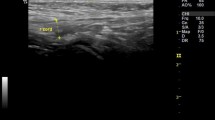Abstract
Herniography has been used for 25 years in the diagnosis of occult herniation but has not gained widespread acceptance in the UK, despite studies confirming its high sensitivity and specificity for occult hernias and an excellent record of safety and patient acceptability. The traditional approach in the UK to suspected occult groin herniation has been surgical exploration. This study examined the use of herniography in a single district general hospital to assess its impact in limiting unnecessary groin explorations and allowing discharge of patients without hernias. The case notes of 90 successive patients referred for herniography by the department of general surgery in a single UK district general hospital over an 18-month period were reviewed. Eighty-seven completed examinations were analysed in which 23 hernias were diagnosed in 20 patients. Thirteen patients have undergone hernia repair with resolution of symptoms. There were no false positive examinations, although two inguinal hernias were incorrectly diagnosed radiologically as femoral hernias; there were two false negative examinations where additional hernias were found at laparoscopic repair. There were no reported complications. Twenty-four patients were discharged directly from the surgical clinic after a negative herniogram. Thirty patients were referred to other specialities. No patient had undergone groin exploration after a negative herniogram. Herniography is a useful tool in assessing obscure groin pain and potential occult herniation. It can reliably rule out the presence of a hernia and avoid the need for surgical exploration. Many patients with a negative herniogram can be reassured and discharged, whilst others may be referred on to other specialities safe in the knowledge that an occult hernia has been excluded.


Similar content being viewed by others
References
Ducharme JC, Bertrand R, Chacar R (1967) Is it possible to diagnose inguinal hernia by X-ray? A preliminary report on herniography. Can Assoc Radiol J 18:448–451
Leape LL (1978) Herniograms—a commentary. Surgery 83:361–362
Gullmo Å (1980) Herniography: the diagnosis of hernia in the groin and incompetence of the Pouch of Douglas and pelvic floor. Acta Radiol Suppl 361:1–76
Ekberg O (1981) Inguinal herniography in adults: technique, normal anatomy and diagnsotic criteria for hernias. Radiology 138:31–36
Hall C, Hall PN, Wingate JP, Neoptolemos JP (1980) Evaluation of herniography in the diagnosis of an occult abdominal wall hernia in symptomatic adults. Br J Surg 77:902–906
Brierly RD, Hale PC, Bishop NL (1999) Is herniography an effective and safe investigation? J R Coll Surg Edinb 44:374–377
Eames NWA, Deans GT, Lawson JT, Irwin ST (1994) Herniography for occult hernia and groin pain. Br J Surg 81:1529–1530
Heise CP, Sproat IA, Starling JR (2002) Peritoneography (herniography) for detecting occult inguinal hernia in patients with inguinodynia. Ann Surg 235:140–144
Sutcliffe JR, Taylor OM, Ambrose NS, Chapman AH (1999) The use, value and safety of herniography. Clin Radiol 54:468–472
Loftus IM, Ubhi SS, Rodgers PM, Watkin DFL (1997) A negative herniogram does not exclude the presence of a hernia. Ann R Coll Surg Engl 79:372–375
Uchokoshi F, Nezu R, Hashimoto J, Yoshikawa Y, Matsuda C, Deguchi T, Souda S (2000) Recurrent inguinal hernia after open tension-free hernioplasty: the efficacy of preoperative herniography. Hernia 4:299–301
Toms AP, Dixon AK, Murphy JM, Jamieson NV (1999) Illustrated review of new imaging techniques in the diagnosis of abdominal wall hernias. Br J Surg 86:1243–1249
Van Den Berg JC, De Valois JC, Go PM, Rosenbusch G (1999) Detection of groin hernia with physical examination, ultrasound and MRI compared to laparoscopic findings. Invest Radiol 34:739–743
Bradley M, Morgan D, Pentlow B, Roe A (2003) The groin hernia—an ultrasound diagnosis? Ann R Coll Surg Engl 85:178–180
Ekberg O, Persson NH, Abrahamson P-A, Westlin NE, Lilja B (1988) Longstanding groin pain in athletes: a multidisciplinary approach. Sports Med 6:56–61
Author information
Authors and Affiliations
Corresponding author
Rights and permissions
About this article
Cite this article
Garner, J., Patel, S., Glaves, J. et al. Is herniography useful?. Hernia 10, 66–69 (2006). https://doi.org/10.1007/s10029-005-0044-4
Received:
Accepted:
Published:
Issue Date:
DOI: https://doi.org/10.1007/s10029-005-0044-4




